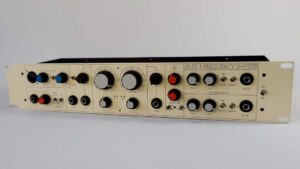Description
This is a project based on Jurgen Haible 20 pole phaser.
This technique is going back to 70s, when there was a black 10 pole filter block as an off the shelf part for different applications. We dont know who made them.
This block was used by many companies. Some units where it was implemented: early ARP Quadra, Aries 329, Tau Systems etc.
TAU systems is an insteresting company that we dont know much about. Probably because their legacy predates the internet erra. But I guess few people knew something and tested some concepts. So new products were made on top of their work and schematics.
Arp quadra tossed the block for production and made their own PCB design for 14 poles. Thats the Phaser sound we know now. Thanks to ARP re-design efforts we know what was inside that black box and we can still use that technique.
If you have any more information about it, I would love to hear it!
20 pole/stage allpassfilter gives us 3600deg of phase shift on the fundamental freq. It creates a lot of resonant “waves” and fills the whole spectrum.
About this particluar unit and design.
Built inside a custom made 19″ steel case, powder painted and screenprinted.
Unit is 1U high and about 16cm deep. We are keeping similar short in depth desing like SOST and FS-1A.
Rear panel has a Fuse and IEC mains inlet socket.
We have used the Haible TAU phaser board as the main.
There are extra 4 boards designed to support the chasis desing.
1. Switch block board.
2. PSU
3. Inputs and outputs with relay bypass.
4. CV in and OUT.
Jacks:
Input MONO, impedance is 10kohm.
Output and AUX, impedance is 10kohm. OUTPUT and AUX are different kind of outputs. They sound different. You can do a pseudo-stereo with them. AUX is more clean, less phasing.
Controls:
Input volume. You can attenuate the input signal if its too hot.
Output volume.
Aux volume.
Resonance. Sets the resonance.
Manual. Sets the phasing freq.
Modulation. This knob is a Manual/LFO mixer. So that you can mix together Manual and LFO signals. Its affecting the phasing freq.
LFO rate. Sets the speed of the internal LFO.
Switches:
Power ON/Off toggle switch for the mains.
BYP/ON is a switch that controls the bypass relay. When the unit is powered off, relay switches to Bypass no matter the switch position. Single RED/GREEN LED indicates the status of the bypass.
VIB/PHASE switches the unit to vibrato or phaser.
NORM/INV switch switches the phase for the fundamental frequencys that are canceling the inputed signal. This is very simple phase inversion, but it affects the audible result in a rather complicated way. There is no right way, test and listen.
FAST/SLW switch is for the LFO speed.
HARD/SMOOTH switch affects the LFO curve, hard is straight up Triangle, smooth rounds the triangle up a bit.
Inside the unit adjustments.
On the main PCB there are 3 usable trimmers.
1) RESO, its another point for resonance trimm, but its a bit different kind of adjustment. Use your ears. I like the unit to self-oscillate. This trimm will alow you to tame it down.
2) GAIN, sets the level for the signal that comes out from the Allpass filter stages. This trimmer sets how much your phaser affects the inputted signal.
3) PITCH, sets the range for the MANUAL and LFO. Adjust to get more low or more high.
Mains voltage slide switch for 115VAC grids and 230VAC grids.
PCBs are available from Random Source.
https://serge-modular.com/haible/tau_phaser
Assembled option:
*Unit is coming without the Power Cable. IEC power cables can be sourced locally.
*Unit is fully assembled and calibrated and tested. No extra work is needed.
*Comes with 230/115VAC mains switch. So the unit can be used in 230VAC or 115VAC grid depending on the switch position. We will flip it to correct position before shipping, but make sure you are aware and see if its correct for your grid.
A video of the Phaser. In this video I am sending very hot 808 track into the phaser. Its overloading the unit and brings up very interesting tones.
From 10sec to 30sec you only hear LEFT channel, thats the center unit playing. From there on, I will turn up the output volume for the lowest unit and you will hear both units in a true stereo configuration. Units are linked together by the CV link so that both units follow the same MANUAL knob. LFOs are not linkable.




